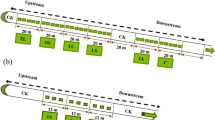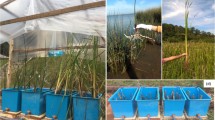Abstract
Nutrient availability and interspecific competition may affect emergent wetland plant growth and resource allocation in constructed wetland. A glasshouse study was conducted to investigate the influence of nutrient and mixture between Canna indica Linn and Schoenoplectus validus (Vahl) A. Löve & D. Löve on their growth and resource allocation in the wetland microcosms, using simulated secondary-treated municipal wastewater effluent with either low (17.5 mg N and 10 mg P l−1) or high (35 mg N and 20 mg P l−1) nutrient concentrations. After 65 days, the high nutrient treatment stimulated plant growth and resulted in allocation of more resources to the above-ground tissues compared to below-ground ones. The concentrations of N and P in the plant tissues (except P in above-ground tissues) were significantly higher, whereas N and P use efficiencies were significantly lower in the high than the low nutrient treatment. The total biomass for C. indica in mixture increased significantly in the high nutrient treatment, but that for S. validus was significantly lower in mixture than in monoculture. Relative yield (RY) indicated that there was significant interspecific competition between S. validus and C. indica in mixtures, with C. indica being the superior competitor. The growth of S. validus was significantly inhibited by the presence of C. indica in their mixture. Compared with monoculture, S. validus in mixture had significantly higher percentages of root biomass and allocations of N and P to roots, whereas C. indica was not significantly affected by mixture. The results suggested that the growth and resource allocation of C. indica and S. validus could be altered by nutrient availability and interspecific competition in constructed wetlands.


Similar content being viewed by others
References
Aerts, R. & F. S. Chapin, 2000. The mineral nutrition of wild plants revisited: a re-evaluation of processes and patterns. Advances in Ecological Research 30: 1–67.
Aerts, R., H. de Caluwe & H. Konings, 1992. Seasonal allocation of biomass and nitrogen in four Carex species from mesotrophic and eutrophic fens as affected by nitrogen supply. Journal of Ecology 80: 653–664.
Agami, M. & K. R. Reddy, 1990. Competition for space between Eichhornia crassipes (Mart.) Solms and Pistia stratiotes L. cultured in nutrient-enriched water Aquatic Botany 38: 195–208.
Bassett, J., R. C. Denney, G. H. Jeffery & J. Mendham, 1978. Vogel’s Textbook of Quantitative Inorganic Analysis Including Elementary Instrumental Analysis. 4th edition. Longman, London, New York.
Calheiros, C. S. C., A. O. S. S. Rangel & P. M. L. Castro, 2007. Constructed wetland systems vegetated with different plants applied to the treatment of tannery wastewater. Water Research doi:10.1016/j.watres.2007.01.012.
Coleman, J., K. Hench, K. Garbutt, A. Sextone, G. Bissonnette & J. Skousen, 2001. Treatment of domestic wastewater by three wetland plant species in constructed wetlands. Water, Air and Soil Pollution 128: 283–295.
Cronk, J. K. & M. S. Fennessy, 2001. Wetland plants: Biology and Ecology. Lewis Publisher, Boca Raton, FL, USA: 462.
Daniels, R. E., 1991. Variation in the performance of Phragmites australis in experimental culture. Aquatic Botany 42: 41–48.
EPA, 2000. U.S. Environmental Protection Agency, Manual, Constructed Wetlands Treatment of Municipal Wastewaters. EPA/625/R-99/010. Cincinnati, OH.
Fu, C., Y. Tang, X. Chen, Y. Xu & G. Xing, 2006. Effects of purification highly salty reuse water quality by three plants in TEDA landscape river. Journal of Chongqing University (Natural Science Edition) 29: 118–121 (in Chinese, with English abstract).
Gaudet, C. L. & P. A. Keddy, 1988. A comparative approach to predicting competitive ability from plant traits. Nature 334: 242–243.
Grime, J. P. & J. G. Hodgson, 1987. Botanical contributions to contemporary ecological theory. New Phytologist 106(Suppl.), 283–295.
Grosse, W., F.W. Wissing, R. Perfler, Z. Wu, J. Chang & Z. Lei, 2001. Water Quality Improvement in Tropical and Subtropical Areas for Reuse and Rehabilitation of Aquatic Ecosystem. In Gawlik B.M., B. Platzer & H. Muntau (eds), Freshwater Contamination in China. Office for official publications of the European Communities, European Communities: 19–32.
Güsewell, S. & U. Bollens, 2003. Composition of plant species mixtures grown at various N:P ratios and levels of nutrient supply. Basic and Applied Ecology 4: 453–466.
Harper, J. L., 1977. Population Biology of Plants. Academic Press, New York.
Hogetu, K., 1984. Bioeconomics. Syokabo Press. Tokyo: 245.
Kadlec, R. H. & R. L. Knight, 1996. Treatment Wetlands. Lewis Publisher, Boca Raton, FL, USA: 893.
Kennedy, M. P., J. M. Milne & K. J. Murphy, 2003. Growth responses to groundwater level variation and competition in freshwater wetland plant species. Wetlands Ecology and Management 11: 383–396.
Kirkman, L. K. & R. R. Sharitz, 1993. Growth in controlled water regimes of three grasses common in freshwater wetlands of the southeastern USA. Aquatic Botany 44: 345–359.
Lorenzen, B., H. Brix, I. A. Mendelssohn, K. L. McKee & S. L. Miao, 2001. Growth, biomass allocation and nutrient use efficiency in Cladium jamaicense and Typha domingensis as affected by phosphorus and oxygen availability. Aquatic Botany 70: 117–133.
McLachlan, S. M., M. Tollenaar, C. J. Swanton & S. F. Weise, 1993. Effect of corn-induced shading on dry matter accumulation, distribution, and architecture of redroot pigweed (Amaranthus retroflexus). Weed Science 41: 568–573.
Poorter, H. & O. Nagel, 2000. The role of biomass allocation in the growth response of plants to different levels of light, CO2, Nutrients and water: a quantitative review. Australian Journal of Plant Physiology 27: 595–607. .
Shi, L., B. Wang, X. Cao, J. Wang, Z. Lei, Z. Wang, Z. Liu & B. Lu, 2004. Performance of a subsurface-flow constructed wetland in southern China. Journal of Environmental Sciences 16: 476–481.
Sipe, T. W. & F. A. Bazzaz, 1994. Gap partitioning among Maples (Acer) in central New England: shoot architecture and photosynthesis. Ecology 75: 2318–2332.
Stuart, J. B., G. G. Georage & K. F. Walker, 1999. Growth and resource allocation in response to flooding in the emerged sedge Bolboschoenus medianus. Aquatic Botany 63: 145–160.
Sundaravadivel, M. & S. Vigneswaran, 2001. Constructed wetlands for wastewater treatment. CRC Critical Reviews in Environmental Science and Technology 31: 351–409.
Tanner, C. C., 1996. Plants for constructed wetland treatment systems–a comparison of the growth and nutrient uptake of eight emergent species. Ecology Engineering 7: 59–83.
Tanner, C. C., 2001. Growth and nutrient dynamics of soft-stem bulrush in constructed wetland treating nutrient-rich wastewaters. Wetland Ecology and Management 9: 49–73.
Tilman, D., 1987. The importance of the mechanisms of interspecific competition. The American Naturalist 129: 769–774.
Tremmel, D. C. & F. A. Bazzaz, 1993. How neighbour canopy architecture affects target plant performance. Ecology 74: 2114–2124.
Tylova-Munzarova, E., B. Lorenzen, H. Brix & O. Votrubova, 2005. The effects of NH +4 and NO −3 on growth, resource allocation and nitrogen uptake kinetics of Phragmites australis and Glyceria maxima. Aquatic Botany 81: 326–342.
Webster, T. M., M. M. Loux, E. E. Regnier & S. K. Harrison, 1994. Giant ragweed (Ambrosia trifida) canopy architecture and interference studies in Soybean (Glycine max). Weed Technology 8: 559–564.
Wetzel, P. R. & A. G. van der Valk, 1998. Effect of nutrient and soil moisture on competition between Phalaris arundinacea, Carex stricta and Typha latifolia. Plant Ecology 138: 179–190.
Wu, J. & L. Ding, 2006. Study on treatment of polluted river water using pilot-scale surface flow constructed wetlands system. Environmental Pollution and Control 28: 432–434 (in Chinese, with English abstract).
Wu, J., S. Huang, X. Ruan & L. Ding, 2006. Treatment of polluted river water using surface flow constructed wetlands in Xinyi river floodplain, Jiangsu Province. Journal of Lake Sciences 18: 238–242 (in Chinese, with English abstract).
Wu, Z. & D. Yu, 2004. The effects of competition on growth and biomass allocation in Nymphoides peltata (Gmel.) O. Kuntze growing in microcosm. Hydrobiologia 527: 241–250.
Yue, C. L., J. Chang, Y. Ge, & Y. M. Zhu, 2004. Treatment efficiency of domestic wastewater by vertical/reverse-vertical flow constructed wetlands. Fresenius Environmental Bulletin 13: 505–507.
Zhang, Z., Z. Rengel & K. Meney, 2007. Nutrient removal from simulated wastewater using Canna indica and Schoenoplectus validus in mono- and mixed-culture in wetland microcosms. Water, Air and Soil Pollution DOI 10.1007/s11270–007–9359–3.
Zhao, J., Q. Yang, Z. Chen & Z. Huang, 2003. Studies on root system biomass of the plants in several kinds of wetland. China Environmental Science 23: 290–294 (in Chinese, with English abstract).
Zhu, X., L. Cui, W. Liu & Y. Liu, 2004. Removal efficiencies of septic tank effluent by simulating vertical-flow constructed Canna indica Linn wetlands. Journal of Agro-Environment Science 23: 761–765 (in Chinese, with English abstract).
Author information
Authors and Affiliations
Corresponding author
Rights and permissions
About this article
Cite this article
Zhang, Z., Rengel, Z. & Meney, K. Growth and resource allocation of Canna indica and Schoenoplectus validus as affected by interspecific competition and nutrient availability. Hydrobiologia 589, 235–248 (2007). https://doi.org/10.1007/s10750-007-0733-3
Received:
Revised:
Accepted:
Published:
Issue Date:
DOI: https://doi.org/10.1007/s10750-007-0733-3




